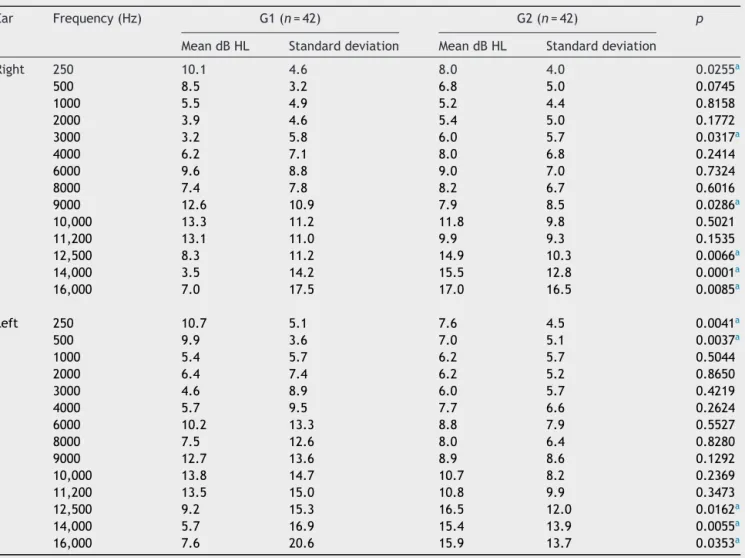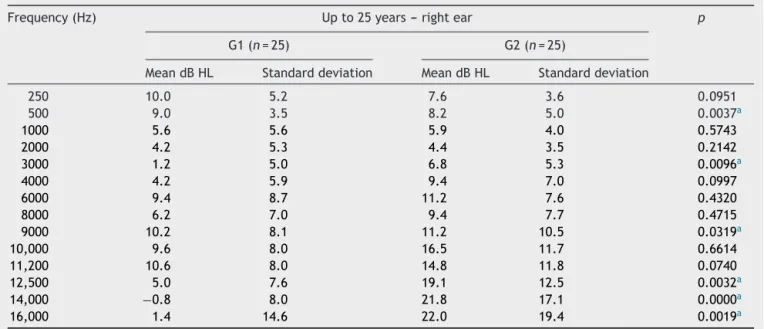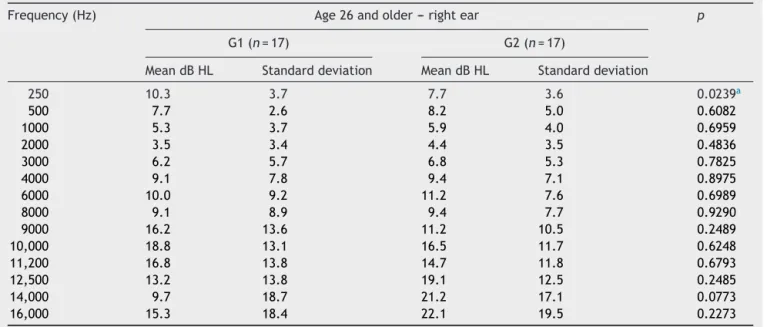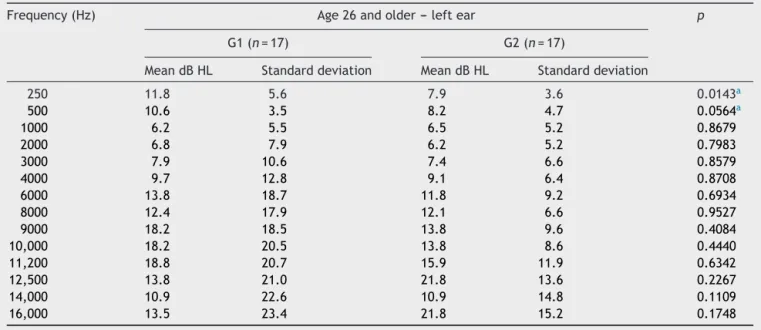Brazilian
Journal
of
OTORHINOLARYNGOLOGY
www.bjorl.org
ORIGINAL
ARTICLE
Music
students:
conventional
hearing
thresholds
and
at
high
frequencies
夽
Débora
Lüders
a,∗,
Cláudia
Giglio
de
Oliveira
Gonc
¸alves
a,
Adriana
Bender
de
Moreira
Lacerda
a,
Ângela
Ribas
a,
Juliana
de
Conto
baUniversidadeTuiutidoParaná,Curitiba,PR,Brazil
bUniversidadeEstadualdoCentro-Oeste(UNICENTRO),Guarapuava,PR,Brazil
Received11March2013;accepted30August2013 Availableonline6June2014
KEYWORDS
Music; Students; Hearing;
Hearingloss;
Audiometry
Abstract
Introduction:Researchhasshownthathearinglossinmusiciansmaycausedifficultyintimbre recognitionandtuningofinstruments.
Aim:Toanalyzethehearingthresholdsfrom250Hzto16,000Hzinagroupofmusicstudents andcompare them to anon-musician group inorder todetermine whetherhigh-frequency audiometryisausefultoolintheearlydetectionofhearingimpairment.
Methods:Study design was a retrospective observational cohort. Conventional and high-frequencyaudiometrywas performedin42 musicstudents(Madsen IteraII audiometerand TDH39Pheadphonesforconventionalaudiometry,andHDA200headphonesforhigh-frequency audiometry).
Results:Ofthe42students,38.1%werefemalestudentsand61.9%weremalestudents,witha meanageof26years.Atconventionalaudiometry,92.85%hadhearingthresholdswithinnormal limits;butevenwithinthenormallimits,theworstresultswereobservedintheleftearfor allfrequencies, exceptfor4000Hz;compared tothenon-musiciangroup,the worstresults occurredat500Hzintheleftear,andat250Hz,6000Hz,9000Hz,10,000Hz,and11,200Hzin boththeears.
Conclusion:Theperiodic evaluationofhigh-frequencythresholdsmaybeusefulintheearly detectionofhearinglossinmusicians.
© 2014Associac¸ãoBrasileira de Otorrinolaringologiae CirurgiaCérvico-Facial. Publishedby ElsevierEditoraLtda.Allrightsreserved.
夽
Pleasecitethisarticleas:LüdersD,Gonc¸alvesCG,LacerdaAB,RibasÂ,deContoJ.Musicstudents:conventionalhearingthresholds andathighfrequencies.BrazJOtorhinolaryngol.2014;80:296---304.
∗Correspondingauthor.
E-mail:debora.luders@yahoo.com.br(D.Lüders).
http://dx.doi.org/10.1016/j.bjorl.2014.05.010
PALAVRAS-CHAVE
Música; Estudantes;
Audic¸ão;
Perdaauditiva;
Audiometria
Estudantesdemúsica:limiaresauditivosconvencionaiseemaltasfrequências
Resumo
Introduc¸ão: Pesquisascomprovamqueaperdaauditivaemmúsicospodegerardificuldadeno reconhecimentodetimbresenaafinac¸ãodosinstrumentos.
Objetivo: Analisaroslimiaresauditivosde250Hza16.000Hzdeum grupodeestudantesde músicaecompará-losaumgrupodenãomúsicosparadeterminarseaaudiometriadealtas frequênciaséumrecursoútilnadetecc¸ãoprecocedadeficiênciaauditiva.
Método: Formadeestudo:observacional,de coorte,retrospectivo. Realizou-se audiometria convencionaledealtasfrequênciasem42estudantesdemúsica(audiômetroMadsenIteraII, fonesTDH39PparaaaudiometriaconvencionaleHDA200paraaudiometriadealtas frequên-cias).
Resultados: Dos42estudantes,38,10%eramdogênerofemininoe61,9%dogêneromasculino, commédiade26anos;naaudiometriaconvencional92,85%apresentaramlimiaresauditivos dentrodospadrõesdenormalidade;mesmodentrodanormalidade,pioresresultadosocorreram naorelhaesquerdaparatodasasfrequências,excetuando-se4000Hz;quandocomparadoao grupodenãomúsicosospioresresultadosocorreramem500Hznaorelhaesquerdae250Hz, 6000Hz,9000Hz,10.000Hze11.200Hzemambasasorelhas.
Conclusão:Aavaliac¸ãodoslimiaresdealtasfrequênciasdeformaperiódicapodeserútilna detecc¸ãoprecocedadeficiênciaauditivaemmúsicos.
©2014Associac¸ãoBrasileiradeOtorrinolaringologiaeCirurgiaCérvico-Facial.Publicado por ElsevierEditoraLtda.Todososdireitosreservados.
Introduction
Music hasalways been connected topeople’s life history,
as a marker of both good times and bad times, and has
increasinglybecomethefocusofattentionofprofessionals
in severalfields, mainlyexperts in hearingand acoustics.
Thisinterestisduetothefactthatexposuretomusicisnot
onlyasocialissue,butalsoaprofessionalissue.
However,whatisintendedtobeenjoyableand
stimulat-ingcandamagethehearing,consideringthatmusic,aswell
asnoiseat highintensities,cancauseirreversibledamage
tohearing.1
Inastudy2 performedinmusicschools inGermany,the
sound intensity duringthe rehearsal of amajor orchestra witharomanticmusicrepertoireexceeded85dB(A).Ifthe musiciansworked foreighthoursaday, fivedaysaweek, noiseexposureformostwouldexceedtheuppertolerance threshold.
Anotherstudy,3 performedby themusic research
insti-tuteoftheUniversityofNorthCarolinaintheUnitedStates, foundthat52%ofthestudentswhoparticipatedina wood-wind instrument band, and who attended one or more rehearsals perweek, wereexposedtosoundlevelshigher than 100%of theallowed dose, according totheNational Institute for Occupational Safety and Health (NIOSH). At above100%ofthenoiselevelsasdefinedbyNIOSH,these students are exposed to very dangerous levels of sound intensity during a singlerehearsal. Atotal of 40 students (representing brasswind, woodwind,and voice)showed a meanlevelof87---95dB(A),withbrasswindshowing signifi-cantlyhigherlevels.
Among the many factors that make grouprehearsals a risktohearingarethedurationofexposure,theintensity ofmusic,theacousticsoftherehearsalspace,proximityto
noisesources(when theyarenot thesound sourceitself, as in the case of singers), choice of repertoire, and the repetition of specific musical passages. Mostly, it is the grouprehearsalthatpreparesstudentsfortheirprofessional careers.Therefore,theconductorsoftheserehearsals are important models for the students. Methods of hearing conservationinthistypeofactivityshouldbeincorporated andsharedbetweentheconductorsandstudentsasamatter ofprofessionallongevity.3
The literature has many studies4---10 that present
hear-inglossasaresultofexposuretomusicathighintensities, alsoaccompanied bysymptomssuchastinnitus,sensation ofearfullness,headache,anddizziness.Thesesymptoms, alongwithnon-auditory manifestationssuch asirritability andfatigue,maybethefirstsignsofhearingdamage.11
Thelossoftheexternalciliatedcells,causedbyconstant andsystematicexposuretohighsoundpressurelevels,can producea reductionin cochlear amplification(motility of theexternal ciliated cells), resultingin loss of sensitivity tolow tomoderatesounds (40---60dB HL).This causesthe musiciantoplayand/orsingatincreasinglyhighervolume, leadingtohigherphysical effortandgreater hearingloss. The loss of external ciliated cells also reduces frequency selectivityandspectralresolutionofthecochlea,leadingto diplacusis(abnormalperceptionofpitch).Thisconditioncan putthemusician’scareeratriskforthosewhooftenmake decisionsaboutthevocaland/orinstrumentaltone perfor-mance. In addition,damageto theexternal ciliated cells leadstolackofcochlearcompressionorrecruitment (abnor-malloudnessperception), which can shortena musician’s career.12
formusicians,canhaveseriousconsequencesfortheir pro-fessionalperformance.13
Conventionalpure toneaudiometry(PTA)is considered thebasisof audiological evaluation,representingthefirst test that composes the assessment. It aimsto determine theindividual’sminimumthresholdofaudibilityfor frequen-ciesfrom250Hzto8000Hz.Thisevaluationtechniqueisthe mostwidelyusedfor thedetectionofhearinglossin indi-vidualsexposedtohighsoundpressurelevels,eithernoise ormusic,especiallyatintensities>85dB(A).14,15
Although hearing disorders can be detected by con-ventional PTA, currently, due to the emphasis on health promotion,professionalsandresearchershaveincreasingly sought to identify these alterations as early as possible. In relation to sensorineural hearing loss, high-frequency audiometryhasbeen usedasawaytodetect these alter-ationsatanearlystage,sothatpreventioncanbeperformed before more significant lesions occur, according to the conceptofhealthpromotion.16
In a literature review17 on the contribution of
high-frequency audiometry to the early identification of noise-inducedhearingloss,theauthorsconcludedthatthe hearing thresholds at high frequencies are often reduced earlierthanconventionalfrequencythresholds,from250Hz to8000Hz,andtherefore,theyshouldbeusedin occupa-tionalhearinglosspreventionprograms.
TheII InternationalCongressofMedicinefor Musicians, held in September 2005 in Spain, stressed that musicians areprofessionalswithahighriskofoccupationaldiseases, alsoemphasizingthatthereisalackofawarenessaboutthis risk,andlittledemandforinformationthatcanpreserveand managethe working conditions of this professional class. Although advances have occurred, preventive and health maintenanceactionsarestillfarfromtheideal.18
Inthefieldofmusic,musicstudentsandteachers, admin-istratorsofmusicschools,andconservatorieshavenotmade anefforttopreventseveralhealthrisksinvolved inmusic learningandperformance.19
Thus, it is imperative that preventive measures are taken,togetherwiththisprofessionalclass,tominimizethe harmfuleffectsofexposuretohighsoundpressurelevels; thisconcernhasledtothisstudy,whichaimedtoanalyze thehearingthresholdsof250---16,000Hzinagroupofmusic studentsandcomparethemtoacontrolgroup,todetermine whetherhigh-frequencyaudiometrycanbeausefultoolfor earlyidentificationofhearingimpairment.
Materials
and
methods
Thiswasanobservational,retrospectivecohortstudywitha quantitativeapproachthatanalyzedtheauditorythresholds of 250---16,000Hz in a group of undergraduate music stu-dents,comparedtoagroupofnon-musiciansandnon-music students.
This research had the approval of the research ethics committee, No. 190/2011, and all individuals assessed signed an informed consent, after receiving information about the objectives, rationale, and methodology of the proposedstudy.
The sample consisted of 84 subjects, divided into two groups:onegroup(G1)consistingof42undergraduatemusic
studentsandonegroup(G2)comprising42individualswho werenon-musiciansandnon-musicstudents,andwhowere notexposedtonoiseatwork.Studentswerefromthree pub-liceducationalinstitutionsdistributedacrossseveralareas of study (music education, popular music, instruments, music compositionandconducting,sound production,and singing)andallparticipatedinacademicpracticeactivities together.
Theinclusion criterionfor group G1comprised beinga music student, and theexclusion criteria included having conductiveand/orsensorineuralhearingdisordersnot asso-ciatedwithnoiseexposure,evaluatedbyaudiometric and imitanciometryassessment.
Initially,visualinspectionoftheexternalauditory mea-tuswasperformed withaKoleotoscopetoverifypossible obstructionsoftheexternalauditorycanalthatcouldimpair theaudiologicalassessment.Onlytwostudentshadexcess wax, which was removed by an otorhinolaryngologist at the clinic where audiological evaluations wereperformed beforethestartoftheexamination.
Theaudiologicalevaluationswereperformedwitha Mad-senaudiometer; modelITERAIIwithTDH39Pheadphones fortheconventionalaudiometry,andHDA200headphones for high-frequencyaudiometryandaudiometric booth.All individualswereassessedaccordingtothecurrentstandards (CFFa,2010).Theauditoryrestbeforetheaudiological eval-uationwas14h.
The conventional PTA assessed air-conduction hearing thresholdsatfrequenciesfrom250Hzto8000Hzandbone conduction hearing thresholds, when the air conduction thresholds showed values >25dB HL for frequencies from 500Hzto4000Hz.
The high-frequency tone audiometry assessed air-conduction hearing thresholds at frequencies of 9000Hz, 10,000Hz,11,200Hz,12,500Hz,14,000Hz,and16,000Hz.
Student’st-testwithasignificancelevelof0.05(5%)was usedforthestatisticalanalysis.
Results
InG1,age rangedfrom18 to58years,witha meanof 26 years,medianof25.7years,andstandarddeviationof7.7 years.Regardinggender,38%werefemalestudentsand62% were male students. The time of musical practicevaried between one and 41 years, witha mean of 11.17 years, medianof10years,andstandarddeviationof8.42years.
Among the 42 students, 69% played string instruments (mainlytheguitar),16.66%playedwoodwindandbrasswind instruments, 16.66%playedthe piano,14.28% played per-cussion,and4.76%sang.Severalstudentsplayedmorethan onemusical instrumentor sangand alsoplayedan instru-ment.Atotalof80%haveplayedand/orsungformorethan fouryears,and56%havebeenamemberofamusicalgroup formorethanfouryears.Allstudents(100%)participatedin academicpracticeactivitiestogether.
InG2,agerangedfrom18to56years,withamean25.8 years,medianof24.5years,andstandarddeviationof7.5 years.Regardinggender,38%werefemalestudentsand62% weremalestudents.
Table1 Meanconventionalandhighfrequencypure-toneair-conductionhearingthresholdsinG1andG2(n=84).
Ear Frequency(Hz) G1(n=42) G2(n=42) p
MeandBHL Standarddeviation MeandBHL Standarddeviation
Right 250 10.1 4.6 8.0 4.0 0.0255a
500 8.5 3.2 6.8 5.0 0.0745
1000 5.5 4.9 5.2 4.4 0.8158
2000 3.9 4.6 5.4 5.0 0.1772
3000 3.2 5.8 6.0 5.7 0.0317a
4000 6.2 7.1 8.0 6.8 0.2414
6000 9.6 8.8 9.0 7.0 0.7324
8000 7.4 7.8 8.2 6.7 0.6016
9000 12.6 10.9 7.9 8.5 0.0286a
10,000 13.3 11.2 11.8 9.8 0.5021
11,200 13.1 11.0 9.9 9.3 0.1535
12,500 8.3 11.2 14.9 10.3 0.0066a
14,000 3.5 14.2 15.5 12.8 0.0001a
16,000 7.0 17.5 17.0 16.5 0.0085a
Left 250 10.7 5.1 7.6 4.5 0.0041a
500 9.9 3.6 7.0 5.1 0.0037a
1000 5.4 5.7 6.2 5.7 0.5044
2000 6.4 7.4 6.2 5.2 0.8650
3000 4.6 8.9 6.0 5.7 0.4219
4000 5.7 9.5 7.7 6.6 0.2624
6000 10.2 13.3 8.8 7.9 0.5527
8000 7.5 12.6 8.0 6.4 0.8280
9000 12.7 13.6 8.9 8.6 0.1292
10,000 13.8 14.7 10.7 8.2 0.2369
11,200 13.5 15.0 10.8 9.9 0.3473
12,500 9.2 15.3 16.5 12.0 0.0162a
14,000 5.7 16.9 15.4 13.9 0.0055a
16,000 7.6 20.6 15.9 13.7 0.0353a
a Student’st-testwithsignificancelevelof0.05.
Table2 Meanconventionalandhighfrequencypure-toneair-conductionhearingthresholdsofrightandleftears,perfrequency, inG1(n=42).
Frequency(Hz) Rightear Leftear p
MeandBHL Standarddeviation MeandBHL Standarddeviation
250 10.1 4.6 10.7 5.1 0.3420
500 8.5 3.2 9.9 3.6 0.0125a
1000 5.5 4.9 5.4 5.7 0.8642
2000 3.9 6.4 4.6 7.4 0.0109a
3000 3.2 5.8 4.6 8.9 0.1477
4000 6.2 7.1 5.7 9.5 0.6818
6000 9.6 8.8 10.2. 13.3 0.7289
8000 7.4 7.8 7.5 12.6 0.9336
9000 12.6 11.9 12.7 13.6 0.9371
10,000 13.3 11.2 13.8 14.7 0.7789
11,200 13.1 11 13.4 15 0.8303
12,500 8.3 11.2 9.2 15.3 0.6238
14,000 3.4 14.2 5.7 16.9 0.0814
16,000 7 17.5 7.6 20.6 0.7249
Table3 Meanpure-tone air-conductionhearingthresholdsofrightandleftears,perfrequency,betweenmaleandfemale genders(n=42).
Frequency(Hz) Male(n=26) Female(n=16) p
MeandBHL Standarddeviation MeandBHL Standarddeviation
RE LE RE LE RE LE RE LE RE LE
250 9.4 12.2 4.5 5.8 11.3 9.8 4.7 4.6 0.2172 0.1463
500 8.5 10.0 3.1 3.7 8.4 9.8 3.5 3.6 0.9816 0.8680
1000 5.6 4.7 3.8 6.7 5.3 5.8 6.4 5.0 0.8680 0.5550
2000 4.2 6.3 4.4 9.6 3.4 6.5 5.1 6.0 0.5955 0.9045
3000 2.7 5.0 5.9 11.1 4.1 4.4 5.8 7.4 0.4659 0.8406
4000 5.6 8.7 7.5 12.2 7.2 3.8 6.3 7.1 0.4793 0.1063
6000 10.4 12.8 9.6 19.9 8.4 8.7 7.5 6.9 0.4926 0.3327
8000 7.5 9.7 7.4 17.6 7.2 6.2 8.8 8.4 0.9018 0.3841
9000 12.5 14.1 12.0 15.3 12.8 11.9 9.3 12.7 0.9297 0.6271
10,000 13.1 13.8 12.2 18.6 13.8 13.8 9.7 12.1 0.8526 0.9839 11,200 14.6 15.3 12.3 18.7 10.6 12.3 8.3 12.4 0.2604 0.5350
12,500 8.3 11.3 11.7 20.8 8.4 7.9 10.6 11.1 0.9629 0.4966
14,000 2.7 8.4 12.3 22.2 4.7 4.0 17.2 12.8 0.6631 0.4188
16,000 2.1 13.1 11.8 25.2 15.0 4.2 22.2 16.8 0.0183a 0.1768 RE,rightear;LE,leftear.
aStudent’st-testwithsignificancelevelof0.05.
audiometry:a20-year-oldstudent(hearinglossat 6000Hz intherightear),whohadplayedtheguitarforthreeyears;a 34-year-oldstudent(hearinglossat8000Hzintheleftear), whohadplayedthetrombonefor20years,anda 36-year-oldstudentwithbilateralalteration(6000Hzintherightear and2000---8000Hzintheleftear),whohadplayedtheguitar foroneyear.Inallthreecases,therearenoreportsofthe useofhearingprotectiondevices.
Table 1 compares the thresholds of conventional and high-frequencyaudiometrybetweenG1andG2.
Itwasobserved thattherewasa significant difference betweenG1andG2atcertainfrequencies;inG1themean thresholdswereworsethanG2atthefrequency of250Hz
inbothears,andat500Hzintheleftear.Thestudygroup hadbettermeanthresholdsonlyat3000Hzintherightear, whencomparedtothecontrolgroup.
Inrelationtohigherfrequencies,therewasasignificant differencebetweenG1andG2at12,500Hz,14,000Hz,and 16,000Hzinbothears,andthemeanthresholdswere bet-ter in the study group than the control group. Only the mean thresholdof the 9000Hz frequency in the right ear wasworseinthestudygroupwhencomparedtothecontrol group.
Table 2 compares the thresholds of conventional pure toneandhigh-frequencyaudiometryofG1intherightand leftears.
Table4 Meanrightearhearingthresholds,perfrequency,forageupto25years(n=50).
Frequency(Hz) Upto25years---rightear p
G1(n=25) G2(n=25)
MeandBHL Standarddeviation MeandBHL Standarddeviation
250 10.0 5.2 7.6 3.6 0.0951
500 9.0 3.5 8.2 5.0 0.0037a
1000 5.6 5.6 5.9 4.0 0.5743
2000 4.2 5.3 4.4 3.5 0.2142
3000 1.2 5.0 6.8 5.3 0.0096a
4000 4.2 5.9 9.4 7.0 0.0997
6000 9.4 8.7 11.2 7.6 0.4320
8000 6.2 7.0 9.4 7.7 0.4715
9000 10.2 8.1 11.2 10.5 0.0319a
10,000 9.6 8.0 16.5 11.7 0.6614
11,200 10.6 8.0 14.8 11.8 0.0740
12,500 5.0 7.6 19.1 12.5 0.0032a
14,000 −0.8 8.0 21.8 17.1 0.0000a
16,000 1.4 14.6 22.0 19.4 0.0019a
Table5 Meanpure-toneair-conductionrightearthresholds,byfrequency,foragerange26andolder,ingroupsG1andG2 (n=34).
Frequency(Hz) Age26andolder---rightear p
G1(n=17) G2(n=17)
MeandBHL Standarddeviation MeandBHL Standarddeviation
250 10.3 3.7 7.7 3.6 0.0239a
500 7.7 2.6 8.2 5.0 0.6082
1000 5.3 3.7 5.9 4.0 0.6959
2000 3.5 3.4 4.4 3.5 0.4836
3000 6.2 5.7 6.8 5.3 0.7825
4000 9.1 7.8 9.4 7.1 0.8975
6000 10.0 9.2 11.2 7.6 0.6989
8000 9.1 8.9 9.4 7.7 0.9290
9000 16.2 13.6 11.2 10.5 0.2489
10,000 18.8 13.1 16.5 11.7 0.6248
11,200 16.8 13.8 14.7 11.8 0.6793
12,500 13.2 13.8 19.1 12.5 0.2485
14,000 9.7 18.7 21.2 17.1 0.0773
16,000 15.3 18.4 22.1 19.5 0.2273
a Student’st-testwithlevelofsignificanceof0.05.
There was a significant difference between the mean thresholds in the right and left ears at frequencies of 500Hz and 2000Hz for the study group, with the left ear showing worse mean thresholds than the right ear.
Table 3comparesthe meanconventional andhigh fre-quency hearingthresholds of G1, takinginto account the frequency,gender,andear.
There was a significant difference between the mean thresholds of male andfemale genders only for the right
earat16,000Hz,withfemalestudentsshowingworsemeans thanthemalestudents.
Table4comparesthemeanconventionalpuretone air-conduction and high-frequency hearing thresholds in the right earbetween G1 and G2 for the age range up to25 years.
ThereisasignificantdifferenceforG1betweenthemean puretoneair-conductionhearingthresholdsinstudentsaged upto25yearsandG2at500,3000,9000,12,500,14,000and 16,000Hz,withthebestresultsreportedbyG1,exceptat
Table6 Meanpure-toneair-conductionthresholdsintheleftear,byfrequency,forageupto25yearsingroupsG1andG2 (n=50).
Frequency(Hz) Upto25years---leftear p
G1(n=25) G2(n=25)
MeandBHL Standarddeviation MeandBHL Standarddeviation
250 10.0 4.8 8.2 4.3 0.0504a
500 9.4 3.6 5.8 4.9 0.0104a
1000 4.8 5.9 4.8 4.7 0.5025
2000 6.2 7.3 6.0 5.8 1.0000
3000 2.4 6.8 5.4 5.9 0.1081
4000 3.0 5.2 7.0 6.6 0.2228
6000 7.8 7.5 7.6 6.3 0.6252
8000 4.2 5.5 7.4 6.0 0.4570
9000 9.0 7.4 5.6 6.0 0.0875
10,000 10.8 8.0 8.6 6.8 0.3147
11,200 9.8 8.1 6.6 5.3 0.2563
12,500 6.0 9.0 12.0 7.5 0.0310a
14,000 2.2 10.7 11.6 6.9 0.0117a
16,000 3.6 17.8 13.6 13.5 0.3410
Table7 Meanpure-toneair-conductionthresholdsintheleftear,byfrequency,foragerange26andolder,ingroupsG1and G2(n=34).
Frequency(Hz) Age26andolder---leftear p
G1(n=17) G2(n=17)
MeandBHL Standarddeviation MeandBHL Standarddeviation
250 11.8 5.6 7.9 3.6 0.0143a
500 10.6 3.5 8.2 4.7 0.0564a
1000 6.2 5.5 6.5 5.2 0.8679
2000 6.8 7.9 6.2 5.2 0.7983
3000 7.9 10.6 7.4 6.6 0.8579
4000 9.7 12.8 9.1 6.4 0.8708
6000 13.8 18.7 11.8 9.2 0.6934
8000 12.4 17.9 12.1 6.6 0.9527
9000 18.2 18.5 13.8 9.6 0.4084
10,000 18.2 20.5 13.8 8.6 0.4440
11,200 18.8 20.7 15.9 11.9 0.6342
12,500 13.8 21.0 21.8 13.6 0.2267
14,000 10.9 22.6 10.9 14.8 0.1109
16,000 13.5 23.4 21.8 15.2 0.1748
aStudent’st-testwithlevelofsignificanceof0.05.
thefrequencyof500Hz,wherebetterresultswereobserved inG2.
Table5 comparesconventionalpure-toneandhigh fre-quency air-conduction hearing thresholds in the left ear betweenG1andG2inthoseaged26yearsandolder.
TherewasasignificantdifferenceforG1betweenmean puretoneair-conductionhearingthresholdsinstudentsaged 26yearsandolderandG2onlyatthefrequencyof250Hz, withthebestresultsreportedbyG2.
Table6comparesthemeanconventionalpure-toneand highfrequencyair-conductionhearingthresholdsintheleft earbetweenG1andG2instudentsagedupto25years.
There wasa significant differencefor G1 between the mean pure tone air-conduction hearing thresholds in stu-dentsagedupto25yearsandG2atfrequenciesof250and 500Hz,whereG1hasworseresultswhencomparedtoG2.As forthefrequenciesof12,500and14,000Hz,thebestresults wereshownbyG1.
Finally, Table7comparesthe meanconventional pure-toneair-conductionandhighfrequencyhearingthresholds intheleftearbetweenthetwogroupsinstudentsaged26 yearsandolder.
There wasa significant differencefor G1 between the mean pure-tone air-conductionhearing thresholds in stu-dentsaged26yearsandolderand G2onlyat frequencies of250and500Hz,withthebestresultsreportedbyG2.
Discussion
Hearinglossinducedbyhighlevelsofsoundpressureoccurs bysystemicandprolongedexposuretoloudsounds(>85dB (A)/8h/day).Withaninsidiousonset,itsmainfeaturesare chronicityandirreversibility,asitaffectstheciliatedcellsof theorganofCorti.20---23Inaddition,accordingtotheNational
CommitteeonNoiseandHearingConservation,notonlythe timeof exposure and sound intensity, but alsoindividual susceptibilityisconsideredasafactorforhearinglossonset.
AccordingtoNR7,AnnexI(1998), hearinglossinduced byhighlevelsofsoundpressureisconsideredaschangesin hearing thresholds resultingfrom systematic occupational exposuretointensesound.Itsmainfeatures,irreversibility andgradualprogressionwithtimeofexposuretorisk, ini-tiallyaffectthefrequenciesof3000Hz,4000Hzor6000Hz, followedby8000Hzand500Hz,andfinally250Hz.
Incomparisonwithconventionalaudiometry,asignificant differencewasobservedbetweenG1andG2atfrequencies of250Hzinbothears and500Hzintheleftear.Although there was no significant difference for the frequency of 6000Hz, the mean pure tone air-conduction thresholds found in G1, at that frequency in both ears, were worse thanthethresholdsshownbyG2.
Thesefindingsareinagreementwithastudy24conducted
with329musicstudents,inwhichtherewasanaudiogram notchatthefrequencyof6000Hzin78%oftheaudiometries performed.
Anotherstudy25observedthat20%ofthemusicstudents
had music-inducedhearing loss (MIHL),andin Brazil, one study16demonstratedthat38.46%ofthemusicstudentshad
anaudiogramsuggestiveofMIHL,followedby46.15% show-inganormalaudiogramwithnotchat3000,4000,or6000Hz. Astudy4 performed with young musicians, aged 18---37
years, found 7% with normal audiogram and presence of notch,and24%oftheaudiogramssuggestedMIHL.
Astudy26conductedwith23rockmusicians,aged21---38
years,withthemajority(57%)intheagerangebetween21 and26years,demonstratedthat,although100%oftheears hadauditorythresholdswithinnormallimits,the distribu-tionofhearingthresholdsshowedalargeconcentrationof worsethresholdsat3000,4000and6000Hz,exactlythose thatarefirstaffectedintheprocessthattriggersMIHL.
withMIHL;thesecond study,28 shows21.7%;andthethird
study29shows19%.Concerninghearinglossinrockandjazz
bands,onestudy30reported52.39%ofmusicianswithMIHL,
andregardinginstrumentalbands,onestudy31observed13%
ofmusicianswithMIHL;anotherstudy8demonstrated52.4%
withMIHL,andathirdstudy6showed24%withhearing
dis-orderssuggestiveofMIHL.
Regardingthelowerfrequencies,theliteratureshowed no findings that either corroborated or contested those foundinthisstudy.Asallparticipatinggroups(G1andG2) underwentaudiometricevaluationunderthesametest con-ditions,itissuggestedthatfurtherstudiesbeperformedto increasetheknowledgeoftheeffectsofhigh-intensitymusic onthelowerfrequencies.
Regarding the thresholds at frequencies of 3000, 4000 and 6000Hz, which, when lowered, can disclose hearing loss due to exposure to high sound pressure levels; it shouldbeemphasizedthatthisstudyobservedadifference, although not significant, between the mean conventional pure-tone air-conduction thresholds for the frequency of 6000Hz between G1 and G2, with a worse mean in G1 (Table 1). The presence of the audiometric notch, even if at only one frequency, should be seen as a warning sign, asit could suggest a trend of the onset of hearing loss.32
Stillinrelationtoconventionalaudiometry,when com-paring the right and left ears of G1, the results of this studyshowedworseresultsintheleftearfor all frequen-cies(exceptfor4000Hz),disclosingasymmetrybetweenthe ears(Table2).
Corroboratingthepresentresults,astudy33onthe
audio-logicalprofileof40symphonicorchestramusiciansresulted inaprofilethatfollowsthepatternofMIHLevolution,but withasymmetricalterationbetweentheears,withtheleft earasthemostaffected.Twostudies27,34reportedgreater
hearing loss in the left ear,both carried out with violin-ists.However,thepresentstudyincludedtheparticipation ofonlytwoviolinstudents.
Fewstudieshavebeenreportedintheliteratureonthe use of high-frequency audiometryfor evaluation of musi-ciansandmusicstudents.Inthepresentstudy,asignificant differencebetweenG1andG2wasfound,withworseresults for G1 only at the frequency of 9000Hz in the right ear. However,themeanthresholdsat9000Hzintheleftearand at 10,000Hz and11,200Hz inboth earswereworse inG1 whencomparedtoG2,althoughnotstatisticallysignificant (Table1).
These findings differ from those of another study,4 as
althoughtheauthorfound meanthresholdsof11dB HLat most,therewasthepresenceofanotchatthefrequency of12,500Hz bilaterally,andat thefrequencyof14,000Hz intherightear.
Inanotherstudy,16anotchwasobservedatthefrequency
of11,200Hzintheleftear,12,500Hzintherightear,and 16,000Hzinbothears;theseresultsalsodifferfromthose ofthepresentstudy.
Conversely,onestudy35evaluatedthetemporarychange
in threshold at 500---14,000Hz in 16 non-professional musiciansbeforeandafter90minofpractice.Allhad expe-rienced repeatedexposurestointensesoundlevelsfor at leastfiveyearsduringtheirmusicalcareers.Theevaluation performedafterthepracticeshowedthelowestthresholds
for frequencies from 500Hz to 8000Hz (p<0.004), with worse results for the frequency of 6000Hz, but there werenodifferencesinthefrequenciesof9000---14,000Hz. Theauthors concluded,basedontheseresults, that high-frequencyaudiometrydoesnotappeartobeadvantageous asa means of early detection of hearing loss induced by high-intensitylevelsofmusic.
Whenanalyzed accordingtoage,for G1upto25years (Table4),althoughtherewasasignificantdifferenceonlyat frequenciesof250Hzintheleftearand500Hzinbothears, theleftearingroupG1alsoshowedtheworstmean thresh-oldsatfrequencies2000Hz,6000Hz,9000Hz,10,000Hzand 11,200Hz,whencomparedtoG2.
ForG1of26yearsandolder,therewasasignificant dif-ference only at the frequency of 250Hz in both ears and 500Hz in the left ear. However, the mean thresholds of G1werealsoworsethanG2atthefrequenciesof2000Hz, 3000Hz,4000Hz,6000Hz,8000Hz,9000Hz,10,000Hzand 11,200Hz in the left ear; and at 9000Hz, 10,000Hz and 11,200Hzintherightear(Table5).
Considering that the hearing loss induced by music or noiseoccursafteryearsofexposureandslowlyprogresses over time, the present study disclosed worse thresholds, althoughstillwithinthenormalrange,forG1atseveral fre-quencies,especiallyintheleftearforthoseolderthan26 years,whencomparedtoG2(Tables4and5).
The three institutions participating in this study offer musiccourseswithabroaddiversityofqualifications,which putsstudents inverydiverse learningsituations.Although commontoallstudents,musicalpracticeduringtraining dif-fersfromcoursetocourse,dependingontheinstitutionand thequalificationofchoiceand,inmostcases,thestudent isnotlimitedtojustonemusicalinstrument.
Inthisphase,theimplementationofahearing conserva-tionprogramforthispopulationcouldbringgreatbenefitsby providingstudentswithallthenecessaryinformationonthe risksofexposuretohigh-intensitymusicandhowtoprevent hearingloss.
Inthepresentstudy,theaudiometricfindings,although mostlywithinthe normalrange,did notrule outpossible earlycochleardamage,whichwereperceivedwhen appro-priatecomparisonsweremade,showingthat thegroupof students (G1) exposed to music almost daily had worse pure-tone air conduction thresholds in the conventional audiometryand athigh frequencies, especiallyinthe left ear(Table1).
High-frequency audiometry is a useful tool to detect earlycochlearalterations.Despitethelackofstandardized normalityparametersandthefactthattheyarerarely per-formedinmusicians,thedifferencesinauditorythresholds athighfrequencies,iffollowedforalongerperiodoftime andalso associatedwithconventional hearing thresholds, canprovideinformationonthehearingstatusofmusicians overtheyears.
Theappearanceofaudiometricnotchesinboth conven-tionalandhigh-frequency audiometrycouldbetter clarify theeffectsofhigh-intensitymusic.
areneitherstrongenoughnorofsufficientdurationtoresult inhearingdamage.
Conclusion
Bothconventionalandhigh-frequencyaudiometrydisclosed statistically significant differences when comparing the audiometric thresholds of the music student group and thegroupconsistingofnon-musicians,non-musicstudents, and those not exposed to noise at work, with the worst thresholdsfound inthegroupofmusicstudents.Themost significantdifferenceswerefoundintheevaluationofhigh frequencies, which allowsfor the inference that sporadic high-frequencythresholdassessmentcanbeusefulinearly detectionofhearinglossinmusicians.
Conflicts
of
interest
Theauthorsdeclarenoconflictsofinterest.
References
1.RussoICP.Acústicaepsicoacústicaaplicadasàfonoaudiologia. 2nded.SãoPaulo:Lovise;1999.
2.RichterB,ZanderMF,SpahnC.HörbelastungundGehörschutz bei Orchestermusikern. Rohrblatt, Frechen. 2008;23:131---6. Sobrecargasonoraeprotec¸ãoauditivaemmúsicosde orques-tra [falta data de acesso]. Available from: http://www. haryschweizer.com.br/Textos/sobrecargaeprotecaoauditiva. htm
3.Wade AB [thesis]Musicians’ hearingloss: defining the prob-lemanddesigningsolutions.SanMarcos:TexasStateUniversity; 2010.
4.Amorim RB, Lopes AC, Santos KTP, Melo ADP, Lauris JRP. Alterac¸õesauditivasdaexposic¸ãoocupacionalemmúsicos.Int ArchOtorhinolaryngol.2008;12:377---83.
5.AndradeAIA,RussoICP,LimaMLLT,OliveiraLCS.Avaliac¸ão audi-tivaemmúsicosdefrevoemaracatu.BrazJOtorhinolaryngol. 2002;68:714---20.
6.Gonc¸alvesCGO,Lacerda ABM,ZocoliAMF,Oliva FC,Almeida SB,Iantas MR.Percepc¸ãoeo impactodamúsica naaudic¸ão de integrantes de banda militar. Rev Soc Bras Fonoaudiol. 2009;14:515---20.
7.SantoniCB[dissertation]Músicosdepop-rock:efeitosdamúsica amplificadaeavaliac¸ãodasatisfac¸ãonousodeprotetores audi-tivos.SãoPaulo:PontifíciaUniversidadeCatólica;2008.
8.MendesMH,MorataTC,MarquesJM.Aceitac¸ãodeprotetores auditivos peloscomponentesde bandainstrumental evocal. BrazJOtorhinolaryngol.2007;73:785---92.
9.NamurFABM,FukudaY,OnishiET,ToledoRN.Avaliac¸ãoauditiva emmúsicosdaOrquestraSinfônicaMunicipaldeSãoPaulo.Braz JOtorhinolaryngol.1999;65:390---5.
10.RussoICP,SantosTMM,BusgaibBB,OsterneFJV.Umestudo com-parativosobreosefeitosdaexposic¸ãoàmúsicaemmúsicosde trioselétricos.BrazJOtorhinolaryngol.1995;61:477---84.
11.MitreEI.Conhecimentosessenciaisparaentenderbema inter-relac¸ão otorrinolaringologia e fonoaudiologia. São José dos Campos:PulsoEditorial;2003.
12.O’neilW,GuthrieMS.DPOAEsamongnormal-hearingmusicians andnon-musicians.HearRev.2001May.Availablefrom:http:// archive.hearingreview.com/issues/articles/2001-0502.asp
Acessedin07/24/2014.
13.MendesMH,MorataTC.Exposic¸ãoprofissionalàmúsica:uma revisão.RevSocBrasFonoaudiol.2007;12:63---9.
14.SantosTMN,RussoICP.Apráticadaaudiologiaclínica.6thed. SãoPaulo:Cortez;2007.
15.Brasil.Ministério do Trabalho eEmprego.Portarian. 19, de 9 de abrilde 1998 da Secretaria de Seguranc¸a e Saúde do Trabalho.Availablefrom:http://portal.mte.gov.br/data/files/ FF8080812BE914E6012BEEB7F30751E6/p1998040919.pdf
Acessedin07/24/2014.
16.Otubo KA,Lopes AC,LaurisJRP. Uma análisedo perfil audi-ológicodeestudantesdemúsica.PerMusi.2013;27:141---51.
17.Lopes AC, Godoy JB. Considerac¸ões metodológicas para investigac¸ãodoslimiaresdefrequênciasultra-altasem indiví-duosexpostosaoruídoocupacional.Salusvita.2006;25:149---60.
18.Costa CP. Contribuic¸ões da ergonomia à saúde do músico: considerac¸õessobreadimensãofísicadofazermusical.Música Hodie.2005;5:53---63.
19.CheskyK.Schoolsofmusicandconservatoriesandhearingloss prevention.IntJAudiol.2011;50:32---7.
20.FerreiraJM.Perda auditivainduzida porruído.Bom sensoe consenso.SãoPaulo:Ed.VK;1998.
21.AlbertiPW.Deficiênciaauditivainduzidapeloruído.In:Lopes FilhoO,CamposCAH,editors.Tratadodeotorrinolaringologia. SãoPaulo:Ed.Roca;1994.p.93---9.
22.MelnickW. Saúdeauditivadotrabalhador. In: KatzJ, editor. Tratadodeaudiologiaclínica.4thed.SãoPaulo:Manole;1999. p.529---44.
23.Henderson D, Hamernik RP. Biologic bases of noise-induced hearingloss.OccupMed.1995;10:513---34.
24.PhillipsSL,HenrichVC,MaceST.Prevalenceofnoise-induced hearinglossinstudentmusicians.IntJAudiol.2010;49:309---16.
25.SchmidtJH, Pedersen ER,Juhl PM, Christensen-Dalsgaard J, Andersen TD,Poulsen T, et al.Sound exposure ofsymphony orchestramusicians.AnnOccupHyg.2011;55:893---905.
26.MaiaJRF,RussoICP.Estudodaaudic¸ãodemúsicosderockand roll.ProFono.2008;20:49---54.
27.RoysterJD,RoysterLH,KillionMC.Soundexposuresandhearing thresholdsofsymphonyorchestramusicians.JAcoustSocAm. 1991;89:2793---803.
28.MarchioriLLM,MeloJJ.Comparac¸ãodasqueixasauditivascom relac¸ãoà exposic¸ãoao ruídoem componentes de orquestra sinfônica.ProFono.2001;13:9---12.
29.LaitinenHM,TopilaEM,OlkinuoraPS,KuismaK.Soundexposure amongtheFinnishNationalOperapersonnel.JOccupEnviron Hyg.2003;18:177---82.
30.SamelliAG,SchochatE.Perdaauditivainduzidapornívelde pressãosonoraelevadoemumgrupodemúsicosprofissionais derock-and-roll.ActaAWHO.2000;19:136---43.
31.MendesMH,KoemlerLA, Assencio-FerreiraVJ.A prevalência deperda auditiva induzidapelo ruídoem músicos debanda instrumental.RevCEFAC.2002;4:179---85.
32.FioriniAC[dissertation]Conservac¸ãoauditiva:estudosobreo monitoramentoaudiométricoemtrabalhadoresdeuma indús-triametalúrgica.São Paulo:PontifíciaUniversidadeCatólica; 1994.
33.Maia AA, Gonc¸alves DU, Menezes LN, Barbosa BMF,Almedia PS, Resende LM. Análise do perfil audiológico dos músicos da Orquestra Sinfônica de Minas Gerais (OSMG). Per Musi. 2007;15:67---71.
34.Azevedo MF, Oliveira C. Audic¸ão de violinistas profissionais: estudodafunc¸ãococlearedasimetriaauditiva.RevSocBras Fonoaudiol.2012;17:73---7.



